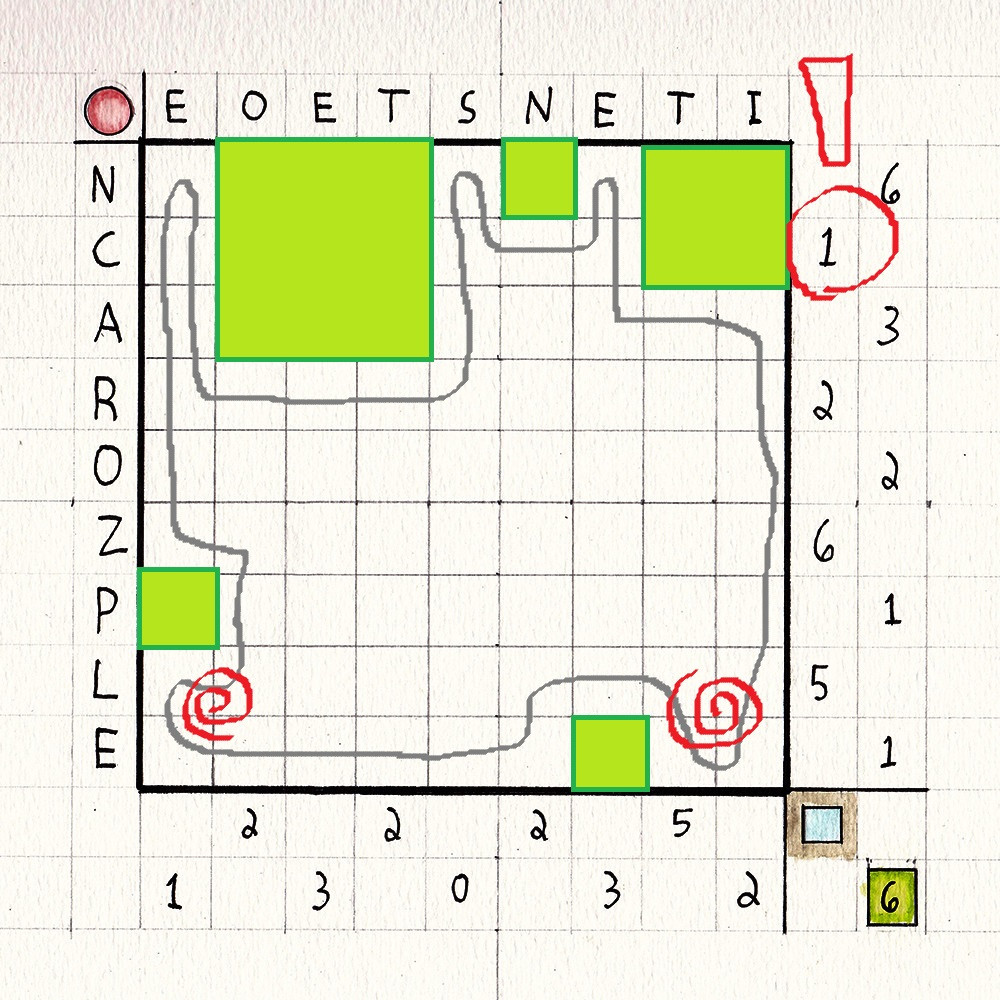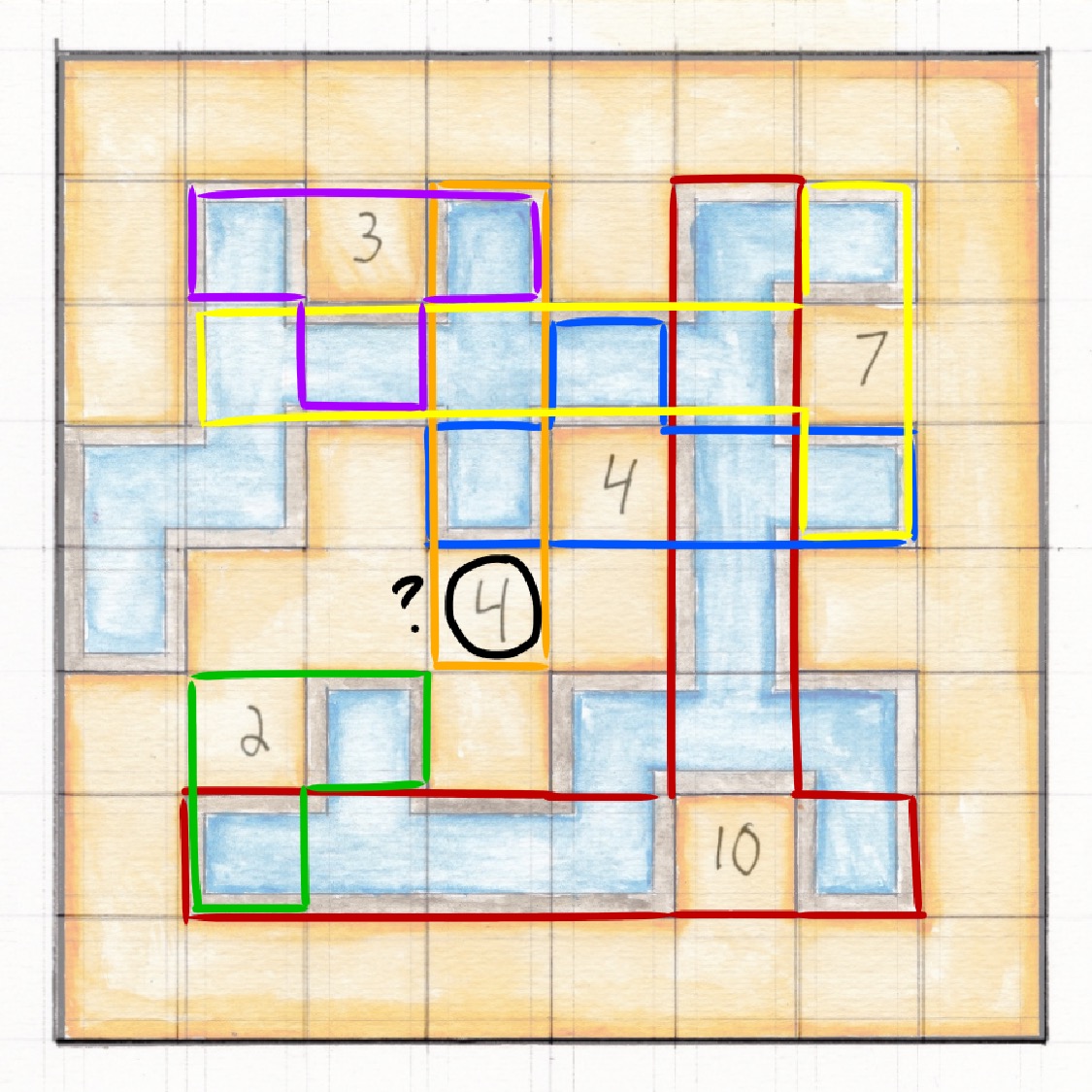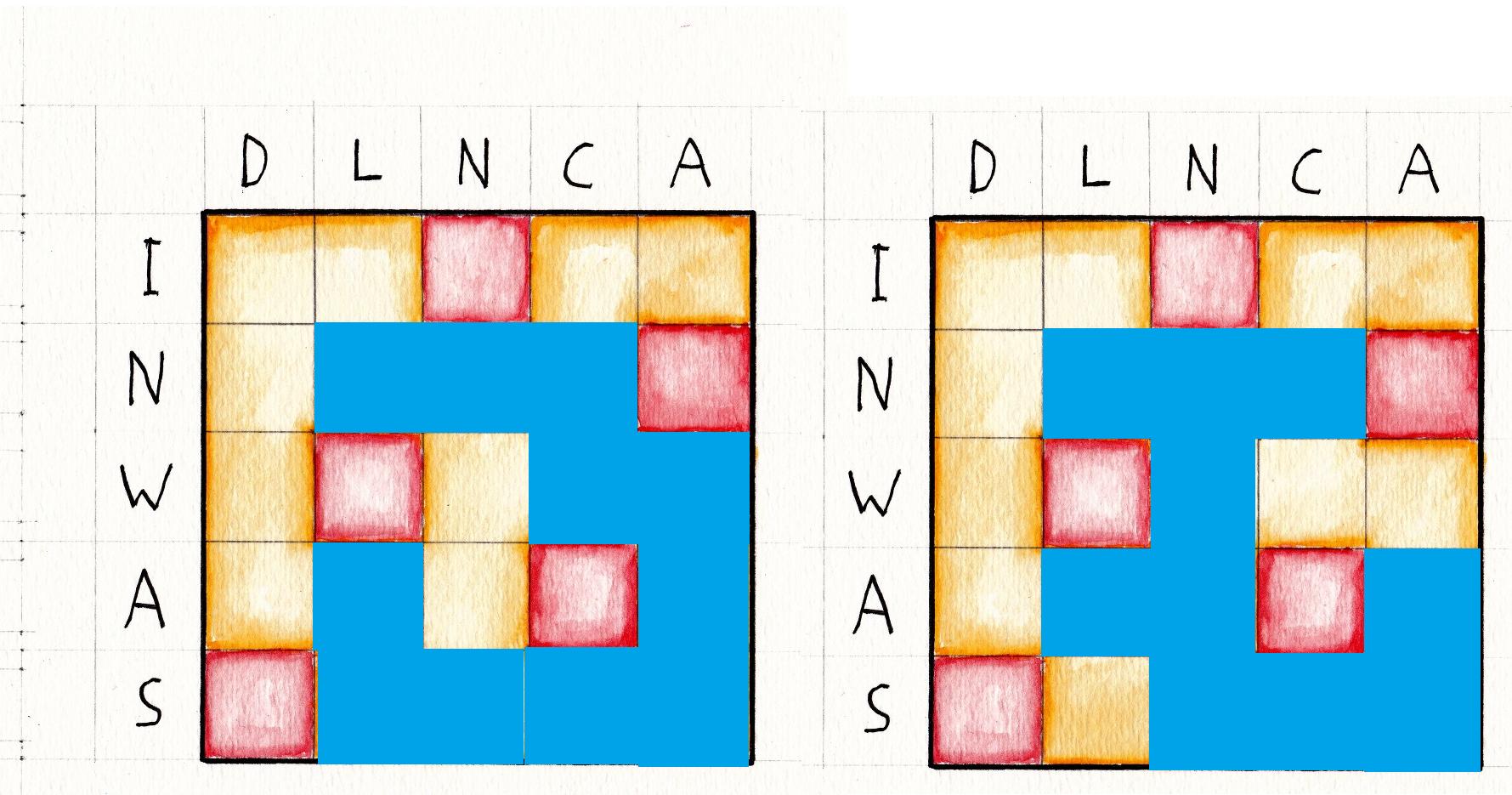Let me try a different approach.
There is one red square in each row and column (fact). That provides us with a free pairwise collocation on rows and columns, or: on the letters written one the up and on the left. This collocations for the first three images (yes, that is a lot of examples!) give you:
1) RC-ET-SE
2) DS-LW-NI-CA-AN
3) ME-AV-NE-AB-DA-OH-SE
Drawing a line through letters is convenient, if we turn around at every collocation (woosh! - left, woosh! - up, woosh! - left again, diving in and out). Now for the first two anagrams are already found, they were just not as explained.
1) SE-[CR]-ET
2) CA-[NA]-LW-[IN]-DS
The third one was harder but still doable (I didn't find any more clues to this one). It's more informative:
3) NE-[VA]-DA-[HO]-ME-[BA]-SE
So, we're talking locations. The hardest part is still to come. The next picture is missing the squares, and anagramising it as is is close to impossible. Yet, we have numbers and experience of as4s4hetic.
THE RULES:
1) There is water and sand. Red is sand (yellow as well). Neither can fold into 2x2 squares. Either is connected.
2) There are trees. Trees are green and square. They are neither sand, nor water. Also, they (probably) don't touch sides of each other.
3) Red sand is in every column and row once (since we already have letters in every row and column)
4) Most important: numbers. Numbers in "water-layer" tell us, how much water in this row/column. Numbers in "tree-layer" tell us, how much wood in this row/column.
5) This '6' in the corner isn't there for fun. It means that we have 6 trees.
That is more than enough to solve the Ncarozple scheme. I'll try to take it slow, because you may not know where to start.
Start with trees. Zero crosses out a column, thus 6 is hard to fit. There is no 4x4 tree in there - it would overload the 3. This 6 is also not 2+1+2+1 because then 3-row needs more trees, 2-row needs more trees, both 1-rows need a 1x1-tree -- we'd be out of (6) trees!
Stay calm and count once more. 3+2+1 = 3 trees. Also 2+1+1 trees in lower rows needed.
Step 2:
Let's wrongfully assume the 3x3 tree (read as: treetreetree) is on the right of the treeless line. First, water-5 on the down wants to fill the column (there is place, even one left for the red sand). Then we can locate two 1x1 trees (on the right). But then the down-3 can't be a 3: it's either 2 or 4 (check yourself)! Reductio to absurdum, we get the 3x3 tree to the left.
Step 3 (I just don't know how to divide spoilers actually):
The 1 and 3 on the down are odd numbers so they require the 1x1 trees to be near. The rest is easy, up to a point that we don't know if 2x2 is up or down and this 1x1 ships are in one of two ways. But now we can start placing water to find out. 
Now comes, what I called "Edge theorem" (I never tried an Yin-Ang before).
If you go along the border in Ying-Yang puzzle, the color changes maximum (and usually, exactly) twice. The reasons for it are connectiviness. What's more important: if we put trees like this, the border creates two points that require to change color (2x2 squares). That results in all the up-part being one color, that counteracts with 1-row. 
The last unusual thing.
We have the trees made, the only other non-Ying-Yang idea I want to use - since every row and every column is supposed to have a red sand, therefore, sand-border goes along all 4 sides, and water-border: 2 maximum. That gives us a take at the borders. The rest is pretty clear.
Now, you would ask:
That's all very pretty, but where are the red squares and the order to read them and location of my dear friend?
Patience here. This data is not enough to find the squares. Probably, I missed something important on the rules or the idea of the shapes. But I can compensate with a mind-game.
QUESTION: What starts with Z next to O (or E, or I) and can be connected to locations of dear friends? It's a Zo-ne. And here it might also be a Dear-friend-zone (yeah I'm good at puns). Though only a hypothesis, marking Z-O and reverse N-E as red squares gives us all the others. Well, not all the other positions, but letters for sure. 
Allright, let's see, it's...
EN-OZ-ER-TO-SP-NE-EC-TA-IL
I spent a lot of time on this one (I still wasn't sure about a 'zone' assumption, btw) and somehow I ended up getting it. The next location hint is
TO-[PS]-EC-[RE]-TA-[LI]-EN-[ZO]-NE !!!
Now it all comes together.
Nevada homebase top secret alien zone is definitely the Area 51. Or not? Unfortunately, I can't finish the decoding. I raise this theme from year ago to let you try once again.
Now, the assumption is:
Shapes are somehow derived from the (filled?) grid. Then, the shapes create order or pattern. This order was supposed to help order the pairs of letters (which I handled myself, so you can reverse-engineer the order I got). The pattern should probably be used on the secret drawer table, to get another message. I don't know if the vellum is needed anywhere.









![enter image description here]](https://i.sstatic.net/sAR5l.jpg)
![enter image description here]](https://i.sstatic.net/jMxqG.jpg)














